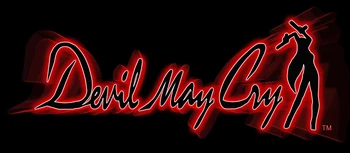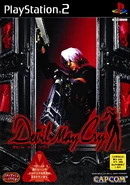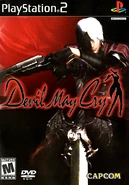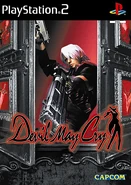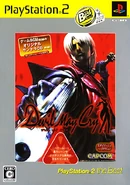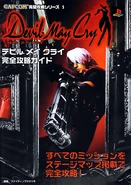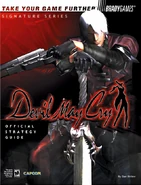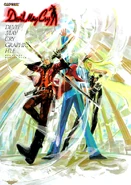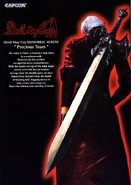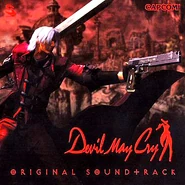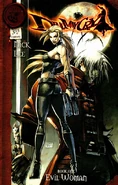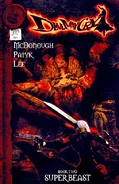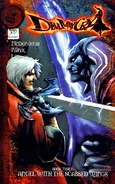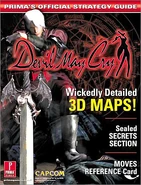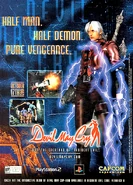Devil May Cry (デビル・メイ・クライ) is a 3D hack and slash action game developed by Capcom Production Studio 4 and published by Capcom in 2001 for the PlayStation 2.

Devil May Cry 1 trailer
Trailer
It is the first game in the Devil May Cry series. The game was originally conceived in 1999 as the earliest version of the survival horror game Resident Evil 4 but due to the staff feeling it would not fit the Resident Evil franchise, the project dropped its ties to Resident Evil 4 and was made into its own story instead.
Devil May Cry received prominent coverage in the gaming media due to the impact it had in both the action game genre and the hack and slash genre. It is not only considered as one of the best and most innovative video games of all time but it has also been cited as the beginning of a subgenre of action games called "Extreme Combat" or "Stylish Action"[1], which focus on powerful heroes fighting hordes of foes with a focus on "stylish action". The game has been described, among other words of praise, as being the first 3D action game that "successfully captured the twitch-based, relentlessly free-flowing gameplay style of so many classic 2D action games" and the series has become the standard against which other similar 3D action games are measured, with comparisons being usually featured in reviews. Devil May Cry has sold more than two million copies and spawned multiple Capcom-developed sequels and prequels.
In 2012, the game was included in an HD compilation, alongside Devil May Cry 2 and Devil May Cry 3, ported to the PlayStation 3.
Set in modern times on the fictional Mallet Island, the story centers on the characters Dante and Trish and their quest to confront the demon lord Mundus. The story is told primarily through a mixture of cutscenes, which use the game's engine and several pre-rendered full motion videos.
Characters
Enemies
- Phantom - is a boss character and one of Mundus' Generals. He is a massive demon resembling a fiery tarantula with a scorpion-like tail. He appears briefly in Devil May Cry 2.
- Frost - a lizard-like demon harnessing the power of ice. A Frost can freeze Dante in place to strike him if the player is not quick enough to avoid their attacks. A host of these creatures returned in Devil May Cry 4.
- Griffon
- Nelo Angelo
- Nightmare
- Mundus
Gameplay
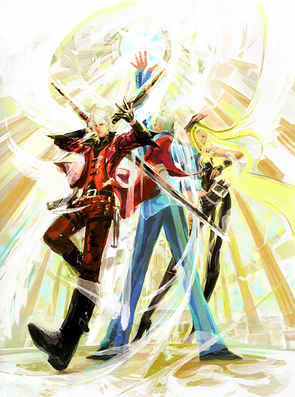
Art by Makoto Tsuchibayashi
The gameplay consists of levels called "missions", where players must fight numerous enemies, perform platforming tasks, and occasionally solve puzzles to progress through the story. The player's performance in each mission is given a letter grade of A, B, C, or D, with an additional top grade of S. Grades are based on the time taken to complete the mission, the amount of "red orbs" gathered (the in-game currency obtained from defeated enemies), how "stylish" their combat was, item usage, and damage taken.
"Stylish" combat is defined as performing an unbroken series of attacks while avoiding damage, with player performance tracked by an on-screen gauge. The more hits the player makes, the higher the gauge rises. The gauge starts at "Dull"; progresses through "Cool", "Bravo", and "Awesome"; and peaks at "Stylish". The gauge terms are similar to the grades you get at the end of the missions. When the character receives damage, the style rating resets back to "Dull". Players can also maintain their style grade by taunting enemies at close range. These combat mechanics are used for most of the game, with three areas that are exceptions. The first is an underwater first-person shooter area, where the player battles enemies with a needle gun. Secondly, during the final boss battle, the gameplay switches to a rail shooter-type environment, and finally a similar rail-shooter level is used for the character's escape from the island by airplane.
The player can temporarily transform the character into a more powerful demonic creature by using the "Devil Trigger" ability. Doing so adds powers based on the current weapon and changes the character's appearance. The transformations typically increase strength and defense, slowly restore health, and grant special attacks. It is governed by the Devil Trigger gauge, which depletes as the ability is used, and is refilled by attacking enemies or taunting in normal form.
Devil May Cry contains puzzles and other challenges besides regular combat. The main storyline often requires the player to find key items to advance, in a manner similar to puzzles in the Resident Evil games, as well as optional platforming and exploration tasks to find hidden caches of "orbs". Side quests, called "Secret Missions" in the game, are located in hidden or out-of-the-way areas and are not required for completion, but provide permanent power-ups. They typically challenge the player to defeat a group of enemies in a specific manner or within a time limit. Rewards for all optional puzzles and challenges come in different types of "orbs" which give bonuses such as allowing the player to purchase power-ups, extend the Devil Trigger ability, or boost total health.
Story
The events in the game are second in the series storyline's chronological order, taking place after the events in Devil May Cry 3: Dante's Awakening, and before Devil May Cry 4 and Devil May Cry 2.
Devil May Cry begins with Dante being attacked in his office by a mysterious woman named Trish. He impresses her by easily brushing off her assault, and tells her that he hunts demons in pursuit of those who killed his mother and brother. She says the attack was a test, and that the demon emperor Mundus, whom Dante holds responsible for the deaths of his family, is planning a return. The scene jumps to their arrival at an immense castle, whereupon Trish abruptly leaps and vanishes over a high wall.
Dante explores the castle and encounters the game's stock enemies, demonic marionettes. He also finds a new sword called Alastor (see also Alastor), and battles the first boss, a giant spider/scorpion demon named Phantom. Dante wins the battle, but in what becomes a recurring theme, the defeated boss monster reappears a short time later in a corridor, forcing the player to choose a narrow escape or to fight in the tight confines. After further exploration and combat, Dante battles a demon named Nelo Angelo, who impresses Dante with his confidence. The demon wins, but suddenly flees upon seeing the half-amulet Dante wears. The demon attacks twice more in later missions, and is eventually revealed to be Dante's identical twin brother, Vergil. After Vergil's final defeat, his amulet joins with his brother's half, and "Force Edge", the game's default sword which belonged to the twins' father, becomes the powerful Sparda sword.
When Dante next meets Trish, she betrays him and reveals that she too is working for Mundus. But when her life is endangered, Dante chooses to save her. Saying he only did so because of her resemblance to his mother, he warns her to stay away. Yet when he finally confronts Mundus, who is about to kill Trish, Dante again chooses to save her and is injured. Mundus tries to finish him off, but Trish takes the attack instead. This unleashes Dante's full power. Dante and Mundus then battle on another plane of existence.
Dante is victorious, and leaves the amulet and sword with Trish's immobile body before departing. Mundus returns and corners Dante, who is now back to his regular strength, before he can flee the island; Trish also returns and lends Dante her power. Dante defeats Mundus, who vows to return and rule the human world. When Trish tries to apologize she begins to cry, and Dante tells her it means she has become human and not just a devil, because "devils never cry". Dante and Trish escape on a plane as the island collapses. After the credits, it is revealed that Dante and Trish are working together as partners, and have renamed the shop "Devil May Cry".
Development
First hinted in early December 1999,[2] Devil May Cry started out as the earliest incarnation of the survival horror game Resident Evil 4. Initially developed for the PlayStation 2, the game was directed by Hideki Kamiya after producer Shinji Mikami requested him to create a new entry in the Resident Evil series.[3] Around the turn of the millennium,[4] regular series writer Noboru Sugimura[5] created a scenario for the title, based on Kamiya's idea to make a "very cool and stylized" action game. The original story was based on unraveling the mystery surrounding the body of protagonist Tony, an invincible man with skills and an intellect exceeding that of normal people, his superhuman abilities explained with biotechnology. As Kamiya felt the playable character did not look brave and heroic enough in battles from a fixed angle, he decided to drop the prerendered backgrounds from previous Resident Evil installments and instead opted for a dynamic camera system. This new direction required the team to make a trip to Europe where they spent eleven days in the United Kingdom and Spain photographing things like Gothic statues, bricks, and stone pavements for use in textures.[6]
Though the developers tried to make the "coolness" theme fit into the world of Resident Evil, Mikami felt it strayed too far from the series' survival horror roots and gradually convinced all of the staff members to make the game independent from it.[7] Kamiya eventually rewrote the story to be set in a world full of demons and changed the hero's name to "Dante". The cast of characters remained largely identical to that in Sugimura's scenario, although appearances of the hero's mother and father were written out of the story. The game's new title was revealed as Devil May Cry in November 2000.
The game was developed by Team Little Devils, a group of staff members, including Kamiya, Mikami and head developer Atsushi Inaba, within Capcom Production Studio 4. Some of the major gameplay elements were partially inspired by a bug found in Onimusha: Warlords. During a test-play, Kamiya discovered that enemies could be kept in the air by slashing them repeatedly, which lead to the inclusion of juggles by gunfire and sword strikes in Devil May Cry.[8] According to the director, Devil May Cry was designed from the ground up around Dante's acrobatics and combat abilities.[9] The decision was made late in the development process to change the game to a more mission-based advancement, instead of the more open-ended structure of the Resident Evil games.[10] Devil May Cry's difficulty was intentional, according to Kamiya, who called it his "challenge to those who played light, casual games".[11] Conceptual designs were handled by Makoto Tsuchibayashi.
Trivia
- By beating the game on Hard Mode, players can unlock Sparda (Dante and Vergil's father) as an alternate in-game skin and replay the entire game as him.
Gallery
Box Art
Merchandise and Advertisements
References
- ↑ https://www.youtube.com/watch?v=SEIyN5Lubsc
- ↑ http://ps2.ign.com/articles/072/072895p1.html
- ↑ http://www.capcom.co.jp/devil/column/vol002.html
- ↑ http://www.capcom.co.jp/devil/column/vol010.html
- ↑ http://game.watch.impress.co.jp/docs/20010411/capcom.htm
- ↑ http://www.capcom.co.jp/devil/column/vol009.html
- ↑ http://ps2.ign.com/articles/094/094860p1.html
- ↑ Electronic Gaming Monthly, December 2001 issue, pg. 56
- ↑ http://www.1up.com/do/feature?pager.offset=1&cId=3152880
- ↑ http://www.gamespot.com/ps2/action/devilmaycry/news.html?sid=2765132
- ↑ http://www.1up.com/do/feature?pager.offset=1&cId=3147448

